Navigating the Challenges of Player Behavior in Overwatch 2's Competitive Landscape

Online multiplayer first-person shooter games are known for their intense competition, especially titles like Overwatch 2, Valorant, CS:GO, Fortnite, and Rainbow Six Siege. Many of these games feature a ranking system that allows players to ascend the ranks in pursuit of excellence. Beginning in the lower ranks, such as iron or bronze, players gradually work their way up through silver and gold. These mid-level ranks are notorious for being challenging to navigate, as many gamers with a bit of skill often find themselves trapped in what is referred to as elo hell. It is at these levels where one is likely to encounter a higher frequency of players exiting the game prematurely and exhibiting negative behavior, in contrast to the atmospheres found at elevated tiers and professional ranks.
Players in the lower ranks of Overwatch 2 often exhibit more negative behaviors and a tendency to exit the game out of frustration.
The average participant in Overwatch 2 may find it somewhat manageable to elevate their rank from initial levels to gold or silver after dedicating some time to the game. The ascent becomes more demanding beyond these ranks, as there is a greater emphasis on consistency over pure skill. Many players here possess sufficient ability but struggle to maintain the regularity needed, leading to frustration, which often results in quitting out of anger and fostering a toxic gaming atmosphere.
According to data from Blizzard, there is an increased likelihood of encountering players who leave mid-game in the lower ranks compared to those positioned higher. This highly charged environment may discourage many players, causing some to cease playing entirely. In response to the issue of toxicity within the game, a representative from Blizzard noted that the rate of players exiting correlates directly with their rank – lower ranks experience a higher rate of exits, while this drops at higher ranks.
The presence of players leaving mid-game remains a persistent challenge across various titles.
Addressing the concern of early exits requires a collective effort to foster positivity and cultivate an atmosphere where players feel at ease. Achieving this necessitates a concerted approach from the community aimed at improving the overall gaming environment.
Toxicity often breeds scenarios where quitting becomes commonplace.
Competitive multiplayer games can bring a lot of frustration, particularly in the case of high-stakes environments like Overwatch 2 or Valorant. The impact of players leaving the game can be substantial. If even one player exits, it can significantly undermine the team's advantage, as these games heavily rely on cooperative gameplay. While toxicity and early exits may be distinct issues, they frequently influence one another. Players positioned at both low and high levels tend to display lower toxicity, while the most negativity is concentrated in the mid-level ranks. Your thoughts on this matter are welcomed in the comments section below.









User's Reviews (0)
Your comment is awaiting moderation. We save your draft here
Leave a comment